Kiruthika Patturaja1, L. Leelavathi2 and Jayalakshmi. S3
1Saveetha Dental College and hospitals, Saveetha Institute of Medical and Technical Sciences, Saveetha University.
2Department of Public Health Dentistry, Saveetha Dental College and hospitals, Saveetha Institute of Medical and Technical Sciences, Saveetha University.
3Department of Conservative Dentistry, Saveetha Dental College and hospitals, Saveetha Institute of Medical and Technical Sciences, Saveetha University.
Corresponding Author E-mail: karleela81@gmail.com
DOI : https://dx.doi.org/10.13005/bpj/1441
Abstract
The aim of the study is to find the rotary instrument usage and preferred brand of rotary instrument among endodontists working in dental colleges, Chennai. A rotary instrument is used to remove or reduce tooth matter and to shape teeth during endodontic procedure. Rotary instrument includes burs and endodontic files. Various brands of rotary instruments are currently available in the market which includes dentsply protaper, Mtwo, endostar, k3 XF files, Heroshaper etc. The choice of rotary instrument by a dentist is governed by various factors like their efficiency, ductility, sharpness, cross section and flexibility. An online questionnaire based study was conducted among 97 endodontists working in dental colleges in Chennai. A total of 10 questions consisting of both open ended and close ended questions related to usage, preferred brand and properties were included in the questionnaire . Datas were collected from the filled questionnaire and analysed. Descriptive statistics was used. From the study it was reported that 88% of endodontists use rotary instruments for endodontic procedures in their clinical practice. The most preferred brand of rotary instrument used by endodontists is Mtwo (40%) because of its good cutting ability and shaping followed by 20% k3, 18% protaper, 6% heroshaper and 36% combination of different rotary instruments. Majority of the endodontists preferred using rotary instruments and nearly half of them opt to use mtwo file in their clinical practice.
Keywords
Flexible Endodontist; Niti; Instruments;Rotary Usage;
Download this article as:| Copy the following to cite this article: Patturaja K, Leelavathi L, Jayalakshmi S. Choice of Rotary Instrument Usage Among Endodontists – A Questionnaire Study. Biomed Pharmacol J 2018;11(2). |
| Copy the following to cite this URL: Patturaja K, Leelavathi L, Jayalakshmi S. Choice of Rotary Instrument Usage Among Endodontists – A Questionnaire Study. Biomed Pharmacol J 2018;11(2). Available from: http://biomedpharmajournal.org/?p=20464 |
Introduction
The root canal treatment consists of removal of bacterial debris from the canal by biomechanical means like cleaning and shaping to prevent reinfection.1 Root canal anatomy is quite complex and to clean and shape these canals successfully requires appropriately designed instruments.2 The cleaning and shaping of root canal systems by various techniques includes usage of hand instruments and rotary instruments. The aim of root canal treatment is to prepare tapered funnel shape with the smallest diameter at the apex and the widest diameter at the canal orifice.
Stainless steel instruments have been used for a long time in endodontics; these instruments are ineffective in the maintenance of the original canal shape because of their low flexibility and its time consuming.3 Lack of flexible nature of stainless steel instruments has led to procedural errors and decreased success rate.4,5 Hand instruments have the tendency to straighten themselves after using in a curved canal and, if used improperly, they could straighten curved canals.6
The engine driven Nickel-Titanium (NiTi) rotary instruments have been engaged in faster and easier root canal system.7 Rotary instruments are preferred by practitioners for their super-elasticity, excellent flexibility, improved cutting efficiencyand better centering ability.8 Rotary instruments have been found to remove filled restorative material efficiently and safely.9,10 Rotary instruments has shown increased fatigue resistance to sterilisation preventing torsional stress.11 However there are certain disadvantages concerned with rotary instruments such as cost and instrument fracture.12
Various brands of rotary instruments are available in market and currently used by endodontists which includes k3, Mtwo , heroshaper, protaper , endostar, HyFlex, etc. The aim of this study is to find the rotary instrument usage and the most preferred brand of rotary instrument used among endodontists working in private dental colleges in Chennai.
Materials and Methods
An online questionnaire based study was conducted among endodontists working in dental colleges. The Questionnaire was circulated among 150 endodontists working in private dental colleges in Chennai, India through mail. This study was conducted from 15th December -31st December 2016. Ethical clearance was obtained from the Institution Review Board for conducting the survey. A sample size of 94 was calculated based on the prevalence of rotary instruments usage in the previous study.17 Convenient sampling methodology was followed to select the study samples. Mail was sent to the endodontists explaining about the purpose of the study. Out of 150 endodontists, 97 accepted to participate in the study. A pretested questionnaire was used and the questionnaire consists of 10 questions which were both open ended and close ended questions. There was neither time limitation nor true/false based questions. The questions were related to the usage, brand, frequency, advantages and limitations of the rotary instrument used. Questions in the questionnaire used were selected from national and international surveys. Participation was voluntary and anonymous and no personal data were collected.
Questionnaire was mailed to them and completely filled questionnaire was considered for analysis. The returned questionnaire containing unanswered questions were excluded. Data was entered in the excel sheet and descriptive statistics were obtained from the data collected.
Results
A cross sectional study was conducted among 97 endodontists working in dental colleges in Chennai and it presented an overall view about the choice of rotary instrument used and preferred among endodontists.
The results of the study showed that 31% of endodontists have used rotary instruments in endodontic practice and 13 % used only hand instruments for cleaning and shaping , while 56 % used combination of both rotary and hand instruments, as they claimed rotary instruments are not used in the anterior tooth region due to lack of cuspal and dentinal walls (figure 1). Based on the convenience ,It was found from the study that around 90 endodontists ie.88% preferred to use rotary instruments for cleaning and shaping of the root canal and about 12 % endodontists preferred to use hand instruments (fig 2).
. Based on the physical properties of rotary instruments about 47 % of endodontists has chosen it flexible which is an important property for working in straight and curved root canals. About 32% of endodontists has reported corrosion resistance as an ideal property and 21% has claimed rotary instruments to be fatigue resistant (figure 3).
Depending upon the frequency of rotary instruments usage in a week for endodontic procedure, 31 (32%) endodontists has used it only once in a week .The highest frequency of rotary instruments usage was found to be three times in a week by 53 endodontists (54.7%) . while about 11 (11.3%) endodontists use rotary instruments five times in a week; rotary usage for more than 5 times in a week was the least reported 2 %. This frequency is based on experience with rotary instruments (table 1). The most preferred brand of rotary instrument is Mtwo by 40% of endodontists, followed by 20% k3, 18 % protaper, 6 % heroshaper and 6% of endodontists use other different brands of rotary instruments (fig 4). About 36% of endodontists use combination of one or more brands of rotary instruments for effective cleaning and shaping. Most commonly used combination of rotary instruments among endodontists in the study were heroshaper and protaper for effective cleaning and shaping (fig 5). Question about advantages of rotary instruments revealed the following response , 35 % of endodontists preferred rotary instruments for its good cutting ability while 22% preferred rotary for its perfect shaping of canals. 18 % of endodontists preferred rotary instruments for its time saving property and 14 % for efficiency of the rotary instrument. Very few endodontists choose rotary instruments to be economical 6% and for its long term usage 5% (figure 6). The most commonly associated limitation of rotary instrument was file fracture by 39 (40%) of endodontists . The least commonly reported limitation of rotary instrument is ledge formation 12 (13%). Other common disadvantages reported by endodontists are canal perforation 20 (21 %) and excess dentin removal 26 (26%) during Canal preparation by rotary instrument (table 2).
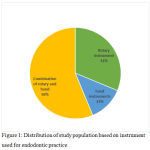 |
Figure 1: Distribution of study population based on instrument used for endodontic practice
|
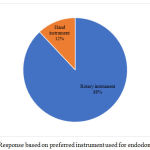 |
Figure 2: Response based on preferred instrument used for endodontic practice.
|
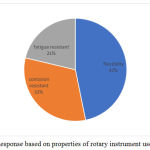 |
Figure 3: Response based on properties of rotary instrument used
|
Table 1: Responses of study participants related to frequency of rotary instrument usage
| Frequency of rotary instrument usage (weekly) | N (%) |
| Once | 31 (32%) |
| 3 times | 53 (54.7%) |
| 5 times | 11 (11.3%) |
| >5 times | 2 (2%) |
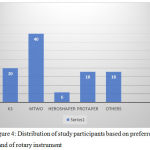 |
Figure 4: Distribution of study participants based on preferred brand of rotary instrument
|
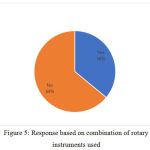 |
Figure 5: Response based on combination of rotary instruments used
|
Table 2: Responses of study participants regarding limitations of rotary instruments
| Limitations of rotary instruments | N (%) |
| File fracture | 39 (40 %) |
| Excess dentin removal | 26 (26 %) |
| Canal perforation | 20 (21 %) |
| Ledge formation | 12 (13 %) |
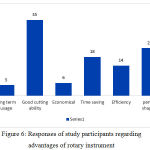 |
Figure 6: Responses of study participants regarding advantages of rotary instrument
|
Discussion
The cleaning and shaping of root canal is one of the important step in endodontic therapy. Cleaning and shaping remove all the tissue debris and inner layers of root canal dentin regardless of the instrumentation technique (3). Rotary instruments has a greater ability to negotiate curved canals and reduce iatrogenic errors by maintaining the original path and allows larger apical preparation of canals.13 Hence a study was done to find the rotary instrument usage among endodontists working in dental colleges in Chennai. The investigations from our study show that most of the endodontists about 88% prefer using rotary instruments for their endodontic practice. In a study conducted by Jyothi.S et al among practitioners in chennai, 2016 it was found that non‐rotary manual endodontic files were commonly used by the practitioners.14
There are various advantages of rotary instruments which include flexibility ,good cutting ability ,time saving and perfect shaping of the canals. The super-elastic property of NiTi, allows safe and effective instrumentation of curved and narrow root canals using hand piece driven instruments operated at low speed.15 It has been reported in our study that flexibility (40%) is an ideal property for usage of rotary instruments . In an invitro study by Peter et al, 2012 it was reported that high fatigue resistance and flexibility was enhanced by HyFlex rotary instruments.16 Machado et al,2010 compared the disinfectant property of two rotary instruments, Pro Taper and Mtwo reduced the amount of bacteria in the mechanical disinfection of the root canal system.17 Few disadvantages are also concerned with the use of rotary instruments which include cost, instrument fracture, difficulty to use and lack of knowledge (4). The major limitation reported was file fracture by 40% of endodontists. Flexural fatigue of rotary instruments is the main reason for file fracture.18 Schirrmeister, J. F. et al 2006, compared hand file and rotary instruments in removing the gutta percha from curved root canals and reported that RaCe system is an efficient and safe device for gutta-percha removal in curved root canal compared to flex master, protaper and hand instruments.19
Recently introduced rotary NiTi files are able to produce a uniformly tapered canal configuration without canal transportation. Electropolishing may have beneficial effects in prolonging the fatigue life of rotary NiTi instruments by reducing them surface irregularities that serve as points for stress concentration and crack initiation.20 However, unpredictable instrument separation remains a deterrent to their popularity. Moreover, cost of rotary files also restrained their use. Majority of practitioners only replaced their instruments when signs of distortion and bluntness were obvious, which is likely to result in a higher risk of instrument separation in the canal (4)
Mohammad Ali et al ,2009 study on the usage of rotary instruments among general dentists and endodontist, general dentists and dental students require more training and more comprehensive education regarding rotary instruments and techniques.21 It was reported by 17% of endodontists that rotary instruments helps in faster canal preparation and is time saving. Abu-Tahun et al, 2015 investigated among fifth year undergraduate dental students in Australia that rotary files were able to prepare root canals faster with more preparation accuracy compared to hand instruments for same tooth.22 Endodontists were significantly more satisfied than those treated by general dentists mainly because of the shorter treatment time by using rotary instruments.23
The most preferred brand of rotary instrument reported was Mtwo (40%) followed by combination of different rotary instruments like Heroshaper, protaper . In a study done by Alavieh Vahid Et al, 2009 in Australia four rotary instruments were compared and assessed for preserving canal curvature, preparation time and change of working length it was reported that Mtwo rotary instruments required significantly less instrumentation time, and the Pro Taper significantly changed the canal curvature (5). In our present study, Canal perforation was reported by 26% of the endodontists. Bier et al, 2009 estimated the ability to induce dentinal damage during canal preparation using NiTi and found that Pro Taper, Pro File, and GT preparations resulted in dentinal defects in 16%, 8%, and 4% of teeth, respectively during canal preparation.24 In the present study it was reported that excess dentin removal 26% is one of the limitation of rotary instruments. Ramanathan et al 2017, in an invitro study concluded that Pro Taper Universal and Pro Taper Next should be used judiciously, as it causes higher thinning of root dentin of the root when compared with Mtwo.25 In the present study, the assessed frequency of rotary instrument used by endodontist was three times (54%) in a week. Parashos et al, 2014 conducted a survey among Australian dentist and reported about 70% of dentists used the instruments two to five times, 19% used six to ten times and 12% used instrument only once this usage paws based on file size and canal shape (4). Rotary instrument usage increased with increasing work experience suggesting that dentist with less experience are less likely to use.21
Therefore it is acknowledged that interpretation of any survey data must consider the possibility of incorrect answers because of factors related to questionnaire design, question wording and respondent factors. Generalisability of this study may be limited, as it represents only views of practitioners working in dental colleges in Chennai.
Conclusion
It can be concluded from the study that majority of endodontists use rotary instruments for endodontic procedures in their clinical practice. Nearly half of the study participants reported that the most preferred brand of rotary instrument was Mtwo because of its good cutting ability and shaping.
References
- Bystrom A, Sundqvist G. Bacteriologic evaluation of the efficacy of mechanical root canal instrumentation in endodontic therapy. Scand J Dent Res. 1981;89:8-321.
CrossRef - Mangalam S .C Rao V. and Lakshminarayanan L. Evaluation of apically extruded debris and irrigant using three instrumentation techniques. Endodontology14. 2002;19-23.
- Ersev, Handan, et al. A comparison of the shaping effects of 5 nickel-titanium rotary instruments in simulated S-shaped canals. Oral Surgery, Oral Medicine, Oral Pathology, Oral Radiology, and Endodontology109. 2010;5:86-93.
CrossRef
CrossRef - Parashos P and Messer H. H. Questionnaire survey on the use of rotary nickel–titanium endodontic instruments by Australian dentists. International endodontic journal37. 2004;4:249-259.
CrossRef - Vahid A, Roohi N, Zayeri F. A comparative study of four rotary NiTi instruments in preserving canal curvature, preparation time and change of working length. Australian Endodontic Journal. 2009;1;35(2):37-9
CrossRef - Cheung, Gary S.P and Christopher S.Y Liu. A retrospective study of endodontic treatment outcome between nickel-titanium rotary and stainless steel hand filing techniques. Journal of endodontics352009;9(7):38-943.
CrossRef - Gambill J.M, Alder M, Carlos E. Comparison of nickel-titanium and stainless steel hand-file instrumentation using computed tomography. Journal of Endodontics. 1996;22(7):75-369.
CrossRef - Daugherty Darrell W, Tom G. Gound and Toby L. Comer. Comparison of fracture rate, deformation rate, and efficiency between rotary endodontic instruments driven at 150 rpm and 350 rpm. Journal of endodontics27. 2001;2:93-95.
CrossRef - Karova E, Dogandzhiyska V. Undergraduate Teaching for Using Rotary Nickel-titanium Endodontic Instruments. International Journal of Dental Sciences and Research. 2016;9;4(6):9-95.
- Hülsmann M and BluhmV. Efficacy, cleaning ability and safety of different rotary NiTi instruments in root canal retreatment. International Endodontic Journal37. 2004;7:468-476.
- Viana A.C, Gonzalez B.M, Buono V.T, Bahia M.G. Influence of sterilization on mechanical properties and fatigue resistance of nickel–titanium rotary endodontic instruments. International Endodontic Journal. 2006; 1;39(9):709-15.
CrossRef - Alapati S.B, Brantley W.A, Svec T.A, Powers J.M, Mitchell J.C. Scanning electron microscope observations of new and used nickel-titanium rotary files. Journal of Endodontics. 2003;31;29(10):667-9.
CrossRef - Walia H, Brantley W.A, Gerstein H. An initial investigation of the bending and torsional properties of Nitinol root canal files. Journal of endodontics. 1988;1;14(7):346-51.
CrossRef - Jyothi S, Pradeep S. Practice of endodontic therapy among practitioners: a questionnaire survey. International Journal of Pharmacy & Technology. 2016;8(3):16546-16558
- Serene T.P, Adams J.D, Saxena A. Nickel-titanium instruments: applications in endodontics. Ishiyaku EuroAmerica. 1995.
- Peters O.A, Gluskin A.K, Weiss R.A, Han J.T. An in vitro assessment of the physical properties of novel Hyflex nickel–titanium rotary instruments. International endodontic journal. 2012;1;45(11):1027-34.
CrossRef - de Lima M.E, Machado L.A.B, Sapia S, Cai G.H, Martins.R, Nabeshima C.K. Comparison of two rotary systems in root canal preparation regarding disinfection. J Endod. 2010;36:1238-1240
CrossRef - Sattapan B, Nervo G.J, Palamara J.E, Messer H.H. Defects in rotary nickel-titanium files after clinical use. Journal of Endodontics. 2000;31;26(3):5-161.
CrossRef - Schirrmeister J.F, Wrbas K.T, Schneider F.H, Altenburger M.J, Hellwig E. Effectiveness of a hand file and three nickel-titanium rotary instruments for removing gutta-percha in curved root canals during retreatment. Oral Surgery, Oral Medicine, Oral Pathology, Oral Radiology, and Endodontology. 2006;30:101(4):542-7.
CrossRef - Anderson M.E, Price J.W, Parashos P. Fracture resistance of electropolished rotary nickel–titanium endodontic instruments. Journal of Endodontics. 2007;31;33(10):1212-6.
CrossRef - Mohammad Ali Mozayeni, Amin Golshah and Nafiseh Nik Kerda. A Survey on NiTi Rotary Instruments Usage by Endodontists and General Dentist in Tehran, Iran. Endod J. 2011;6(4):168–175.
- Abu‐Tahun I, Al‐Rabab’ah M.A, Hammad M, Khraisat A. Technical quality of root canal treatment of posterior teeth after rotary or hand preparation by fifth year undergraduate students, The University of Jordan. Australian Endodontic Journal. 2014;1;40(3):123-30.
CrossRef - Dugas N.N, Lawrence H.P, Teplitsky P, Friedman S. Quality of life and satisfaction outcomes of endodontic treatment. Journal of endodontics. 2002;31;28(12):819-27.
CrossRef - Bier CA, Shemesh H, Tanomaru-Filho M, Wesselink PR, Wu MK. The ability of different nickel-titanium rotary instruments to induce dentinal damage during canal preparation. Journal of Endodontics. 2009;28;35(2):236-8.
CrossRef - Ramanathan S, Solete P. Cone beam computed tomography evaluation of root canal preparation using various rotary instruments: an invitro study. The journal of contemporary dental practice. 2017;16(11):869-872.
CrossRef








